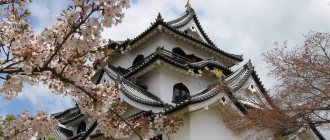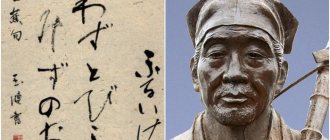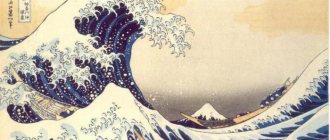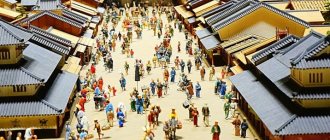presentation “Culture of Japan” presentation for a geography lesson (grade 11) on the topic
Slide 1
Culture of Japan the work was completed by a student of grade 11a, Municipal Educational Institution Secondary School No. 43, Borzya Gypsy Christina 日本の文化
Slide 2
The culture of Japan developed as a result of a historical process that began with the migration of the ancestors of the Japanese people to the Japanese archipelago from the mainland and the emergence of culture during the Jomon period. Modern Japanese culture has been heavily influenced by Asia (especially China and Korea), Europe, and North America, which rapidly began to influence Japanese culture in the early 1960s. One of the features of Japanese culture is its long development during the period of complete isolation of the country (policy of sakoku) from the rest of the world during the reign of the Tokugawa shogunate, which lasted until the mid-19th century - the beginning of the Meiji period. The culture and mentality of the Japanese were greatly influenced by the isolated territorial position of the country, geographical and climatic features, as well as special natural phenomena (frequent earthquakes and typhoons), which was expressed in the peculiar attitude of the Japanese towards nature as a living creature. The ability to admire the momentary beauty of nature, as a feature of the national character of the Japanese, has found expression in many types of art in Japan.
Slide 3
Japanese language and writing The Japanese language has always been an important component of Japanese culture. The majority of the country's population speaks Japanese. Japanese is an agglutinative language and is characterized by a complex writing system consisting of three different types of characters - Chinese kanji characters, hiragana and katakana syllabaries. ひらがな
Slide 4
Calligraphy In Japan, calligraphy is considered one of the arts and is called shodo (Japanese: 書道 “way of writing”). Along with drawing, calligraphy is taught in schools. The art of calligraphy was brought to Japan along with Chinese writing. In ancient times in Japan, mastery of the art of calligraphy was considered a sign of a cultured person.
Slide 5
For a long time, Japanese literature was influenced by China, and literary works were also created in Chinese. The first written monuments are considered to be the collection of Japanese myths and legends “Kojiki” (“Records of Ancient Deeds”) and the historical chronicle “Nihon Shoki” (“Brush-written Annals of Japan” or “Nihongi” - “Annals of Japan”), created during the Nara period (VIIth - VIII centuries). Both works were written in Chinese, but with modifications to convey Japanese names of gods and other words. During the same period, the poetic anthologies "Man'yoshu" (Japanese: 万葉集 "Collection of Myriad Leaves") and "Kaifuso" (Japanese: 懐風藻) were created. The types of poetic forms haiku (Japanese: 俳句), waka (Japanese: 和歌 “Japanese song”), and a variety of the latter tanka (Japanese: 短歌 “short song”) are widely known outside Japan. Literature The scarlet water flower I cut off with a blow of a sickle Between the oncoming waves. Hirose Izen
Slide 6
Anime and manga Anime is Japanese animation. The main difference from animation in other countries is that most of the products produced are designed for teenage and adult audiences, and due to this they are highly popular in the world. Almost all anime series are film adaptations of Japanese comic books - manga, usually preserving the graphic style and other features.
Slide 7
Manga are Japanese comics, sometimes called komikku in their homeland. The word "manga" means "grotesque", "strange (or funny) pictures", and the artist who draws it is called mangaka. In Japan, comics are read by people of all ages and are respected both as a form of fine art and as a literary phenomenon. Manga is almost always black and white, and only covers and individual illustrations are drawn in color.
Slide 8
Japanese painting is one of the most ancient and sophisticated of Japanese arts, characterized by a wide variety of genres and styles. Painting Since the 10th century, the Yamato-e direction has been distinguished in Japanese painting; the paintings are horizontal scrolls that were used to illustrate literary works. In the 14th century, the style of sumi-e (monochrome watercolor) developed, and in the first half of the 17th century, artists began to print ukiyo-e - woodblock prints depicting geishas, popular kabuki actors and landscapes. The influence of the popularity of ukiyo-e prints on 18th-century European art is called Japonism.
Slide 9
Sculpture The oldest form of art in Japan is sculpture. Since the Jomon era, a variety of ceramic products (ware) have been made, and clay dogu idol figurines are also known. During the Kofun era, haniwa were installed on graves - sculptures made of baked clay, initially simple cylindrical shapes, and then more complex - in the form of people, animals or birds. Wood was used as the main material for sculptures (as in Japanese architecture). Statues were often varnished, gilded, or brightly painted. Bronze or other metals were also used as material for statues. The most prominent representatives of Japanese wooden sculpture were Enku (1632-1695) and Mokujiki (1718-1810).
Slide 10
Architecture Examples of traditional Japanese architecture include temples, Shinto shrines and castles in Kyoto and Nara. In general, Japanese architecture is characterized by a desire for simplicity. Traditional wooden residential buildings of ordinary Japanese, called minka, are maximally adapted to the country's climate. The minka has a frame structure with a load-bearing column in the center of the house and sliding doors. Currently, minkas are preserved only in rural areas. Japanese castles were distinguished by their originality, serving not only to protect their owners from enemies, but also as a symbol of power.
Slide 11
Cinema The first Japanese films of the early 20th century had simple plots, the cinema of this period developed under the influence of the theater, the acting was theatrical, female roles were played by male actors, theatrical costumes and scenery were used. Before the advent of sound cinema, film screenings were accompanied by a benshi - a live performer, the Japanese version of a pianist. At first, cinema was considered a low art, and there was a contemptuous attitude towards people involved in cinema. This type of art received recognition and authority only in the late 30s of the 20th century.
Slide 12
Music Japanese music includes many genres, ranging from traditional music genres unique to Japan itself, to many genres of modern music, around which the country often builds a distinctive scene, unlike other countries. Since the 1990s, Japanese music has become widely known and popular in the West, primarily due to its unique genres such as j-pop, j-rock and visual kei. Often such music reaches Western listeners through soundtracks in Japanese animation or video games, and visiting Japanese groups and performers perform at almost every one of the various Japanese cultural festivals.
Slide 13
Military culture Samurai are a Japanese military-feudal class. They appeared in Japan in the 7th-8th centuries AD. Mostly men from wealthy peasant families, as well as representatives of the middle and lower aristocracy, became samurai. From warriors, samurai gradually became armed servants of their feudal lord, receiving housing and food from him. Sometimes samurai received land plots from the peasants, and themselves turned into feudal lords. The number of samurai increased, and soon the squads of feudal lords began to represent entire armies.
Slide 14
Bushido is the code of the samurai, a set of rules, recommendations and norms of behavior of a true warrior in society, in battle and alone, a military male philosophy and morality, rooted in ancient times. Bushido, which initially arose in the form of the principles of a warrior in general, thanks to the ethical values and respect for the arts included in it in the 12th-13th centuries, with the development of the samurai class as noble warriors, merged with it and finally took shape in the 16th-17th centuries. already like a code of samurai ethics. Postulates: True courage is to live when it is right to live, and to die when it is right to die. One should approach death with a clear consciousness of what a samurai should do and what humiliates his dignity. You should weigh every word and always ask yourself whether what you are about to say is true. Loyalty, justice and courage are the three natural virtues of a samurai. The samurai must, first of all, constantly remember that he can die at any moment, and if such a moment comes, then the samurai must die with honor. This is his main business.
Slide 15
Secret ninja clans began to appear in Japan in the 9th-12th centuries, almost simultaneously with the emergence of the samurai. Ninjas were, in fact, highly professional intelligence officers and saboteurs of that time, possessing a complex of knowledge and skills in camouflage, killing methods, organizing guerrilla operations and obtaining information. Various feudal princes used the specific services of ninja clans. The heyday of ninja art came during the civil war of 1467-1568, at that time there were about 70 ninja clans in Japan. Most legends about ninjas are based on the events of that “era of the warring states.”
Slide 16
Martial arts Judo means "gentle way" in Japanese. This martial art is the most recognized in the world. Judo was created at the end of the 19th century by the master Kano Jigiro, who took one of the schools of jujutsu as a basis and developed the rules of a new martial art and a fighting system. Karate is a martial art that originated in China. From there it came to the island of Okinawa, which was independent for a long time, and then became the outskirts of Japan, so few people were interested in karatedo in Japan. Karate became popular in the 1920s thanks to a master named Funakoshi Gichin. Since then, karate has taken an important place among Japanese martial arts. Sumo is a special type of martial art. It was never used in battle, but had a ritual character, combining sport and Shinto ritual. Modern sumo also preserves many ancient rituals. Aikido is a martial art created by master Ueshiba Morihei on the basis of one of the schools of jujutsu. This combat system is fundamentally different from others in that it does not have offensive technology. Aikido is used for defense, using the opponent's strength against him.
Slide 17
Cuisine The Japanese say: “Every meal should have something from the mountains and something from the sea.” “Mountain” ingredients are usually rice and seasonal vegetables, as well as soybeans and their numerous derivatives (tofu bean curd, miso soy paste, shoyu soy sauce). The “sea” part of food can be very diverse: almost all types of sea fish, many types of shellfish (even jellyfish), cetaceans, seaweed and other algae. The constant lack of food taught the ancient Japanese to respect their daily meals. The consumption of everyday foods was accompanied by some kind of rituals, and they tried to add at least aesthetic appeal to the food. The Japanese strive to decorate their food in any way possible. They even say that the Japanese eat with their eyes, not their mouths.
Slide 18
Religion In matters of religion, Japan shows the greatest tolerance. Thus, almost all Japanese profess Shintoism, but at the same time belong to one of the many Buddhist communities, guided in life by the principles of Confucianism. Shintoism - “the way of the gods” - is the oldest religion in Japan, cultivated exclusively in this country. It is based on the myth of the origin of the world, according to which the Earth and the imperial family trace their origins to the Sun Goddess Amaterasu. At the center of Buddhism is the teaching of the “four noble truths”: suffering, its cause, liberation and the path to it. In Buddhism there is no opposition between spirit and matter, there is no God as a creator and an unconditionally supreme being. Buddha is not only the name given to the founder of this religion, the legendary Prince Gautama (VII-VI centuries BC), but also the name of a being who has reached a state of highest perfection (“enlightenment”).
Slide 19
Clothing In Japan you can find two types of clothing - traditional - wafuku and simpler, everyday, European style. Kimono, literally translated as “clothing, attire,” is a general term for any clothing, and in a narrower sense, a type of wafuku.
Slide 20
G this, waraji - sandals Yukata - light robe Hakama - pants Obi - belt
Slide 21
Theater and dance The very first type of theater was the Noh theater, which was formed in the 14-15th century; when playing in it, the actors put on masks and dressed in luxurious attire. In the 17th century, one of the most famous types of national theater in Japan, kabuki, was created; complex makeup was applied to the actors’ faces. The skill of onnagata, actors who play the role of a woman, is especially appreciated. In 1629, the Tokugawa shogunate banned women from playing kabuki, after World War II women began to appear on stage again, and even the first all-female troupe was created. The national bunraku puppet theater is also famous. Certain playwrights, such as Chikamatsu Monzaemon, created plays for bunraku, which were later performed in the “big theater” - kabuki.
Slide 22
Traditions, customs, etiquette Japanese society is characterized by a clearly demonstrated sense of belonging to a specific social class (family, work team, student group), which is also manifested in peculiar connections within the community. In Japan, the concepts of “duty” and “obligation,” called giri, are of particular importance. Despite the fact that kettlebells are a general social norm for Japanese behavior, in some situations, particularly among young people, kettlebells are not taken so seriously. In Japan, there are certain norms of gestures, and the more reserved a person is, the more respectful he is treated, so a friendly tap on the shoulder and tugging on the hand will not be welcomed in the land of the rising sun.
Slide 23
Arigato for your attention!
Painting
Japanese painting (絵画 kaiga, “painting, drawing”) is one of the most ancient and sophisticated of Japanese arts, characterized by a wide variety of genres and styles. Japanese painting, as well as literature, is characterized by assigning a leading place to nature and depicting it as the bearer of the divine principle. Since the 10th century, the Yamato-e direction has been distinguished in Japanese painting; the paintings are horizontal scrolls that were used to illustrate literary works. In the 14th century, the style of sumi-e (monochrome watercolor) developed, and in the first half of the 17th century, artists began to print ukiyo-e - woodblock prints depicting geishas, popular kabuki actors and landscapes. The influence of the popularity of ukiyo-e prints on European art in the 18th century is called Japonism.
Anime and manga.
Anime (Japanese アニメ [anime], from English animation [animation] - animation) is Japanese animation. The main difference from animation in other countries is that most of the products produced are designed for teenage and adult audiences, and due to this they are highly popular in the world. Most anime series are film adaptations of Japanese comic books - manga, usually preserving the graphic style and other features. Manga (Japanese: 漫画) - Japanese comics, sometimes called komikku (コミック) in their homeland. The word “manga” means “grotesque”, “strange (or funny) pictures”, and the artist who draws it is called a mangaka. In Japan, comics are read by people of all ages and are respected both as a form of fine art and as a literary phenomenon. Manga is almost always black and white, and only covers and individual illustrations are drawn in color.
Culture and customs of Japan.
Many customs and traditions of Japan set the rhythm of life and behavior of the Japanese. This is especially noticeable in communication. For example, it is not customary for the Japanese to shake hands. Handshakes replace bows - hands at your sides, the body bends at the lumbar region. Moreover, you need to respond to bows with the same frequency with which you were greeted. Another interesting point that often confuses foreigners. Under any circumstances, during communication, Japanese people (especially women) should smile, even if the topic of conversation is serious or sad. It is also not recommended to look a Japanese person directly in the eyes or gesticulate excessively when speaking - this can be perceived as aggression. The Japanese are very friendly and hospitable. They will always come to the rescue at the first request. It is true that when it comes to being treated on the street, old people and teenagers are embarrassed to answer questions. Better turn to the older generation.










